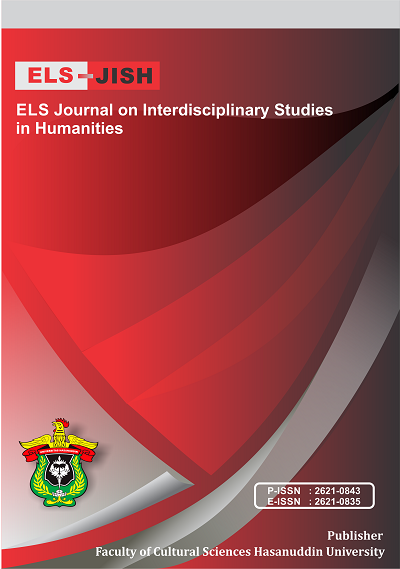Strategies Used by Professional Interpreter in Indonesian-English Simultaneous Interpreting
DOI:
https://doi.org/10.34050/elsjish.v6i3.28117Keywords:
Interpreting, Simultaneous, StrategiesAbstract
The practice of simultaneous interpreting presents complex challenges due to its immediate nature and the need for prompt responses. Simultaneous interpreters are required to perform their tasks immediately in order to match the speaker’s pace. This may lead to information overload and difficulties in dealing with complex sentence structures or specialized terminology. In order to overcome the challenges encountered in simultaneous interpreting, interpreters employ a range of interpreting strategies. This study aims to investigate the strategies applied by a professional interpreter in the YouTube video entitled “Simultaneous Interpreting Example”. Qualitative method was applied in this study and the data was collected through observation and note-taking. The data was analyzed by applying the theory of interpreting strategies proposed by Li (2015). The result of the study revealed that there were six interpreting strategies employed by the interpreter in the video, namely addition, paraphrasing, compression, omission, segmentation, and restructuring. Addition is the most dominant strategy applied, followed by paraphrasing, and compression. These strategies enabled the interpreter to adapt to distinct language structures, improve audience comprehension, and efficiently convey complex ideas in cross-linguistic communication.Downloads
References
Afrina, R., & Ardi, H. (2021). The Strategies of English Department Students of Universitas Negeri Padang in Interpreting English Short Speech into Bahasa Indonesia. Journal of English Language Teaching, 10(1), 80–95. https://doi.org/10.24036/jelt.v10i1.111744
Arum, A. A. (2022). Effects of presentation delivery rate on errors in simultaneous interpreting: A pilot study. Indonesian Journal of Applied Linguistics, 12(1), 30–41. https://doi.org/10.17509/ijal.v12i1.46538
Gile, D. (2009). Basic Concepts and Models for Interpreter and Translator Training (Revised). Amsterdam: John Benjamins Publishing Company.
Hastuningdyah, W. (2019). Understanding Interpreting Strategies: Case Study in Consecutive Interpreting in Jokowi and Malcolm Turnbull Press Conference. SALTeL Journal (Southeast Asia Language Teaching and Learning), 2(1), 57–63. https://doi.org/10.35307/saltel.v2i1.23
Korpal, P., & Stachowiak-Szymczak, K. (2020). Combined problem triggers in simultaneous interpreting: exploring the effect of delivery rate on processing and rendering numbers. Perspectives: Studies in Translation Theory and Practice, 28(1), 126–143. https://doi.org/10.1080/0907676X.2019.1628285
Kuswoyo, H., & Audina, A. Y. (2020). Consecutive Interpreting Strategies on A Court Setting: A Study of English into Indonesia Interpretation. Teknosastik, 18(2), 90–102. https://doi.org/10.33365/ts.v18i2.750
Latief, M. R. A., Khaerana, A. S. A., & Soraya, A. I. (2022). Translation Analysis: Syntactic, Semantic, and Pragmatic Strategies Used in Translating A Website of an Academic Institution. ELS Journal on Interdisciplinary Studies in Humanities, 5(3), 539-550
Li, X. (2015). Putting interpreting strategies in their place. Babel. Revue Internationale de La Traduction / International Journal of Translation, 61(2), 170–192. https://doi.org/10.1075/babel.61.2.02li
Li, Y., & Dong, Y. (2022). Use of explicitation by interpreting students and its contribution to consecutive interpreting performance: A developmental perspective. Perspectives: Studies in Translation Theory and Practice, 30(1), 103–119. https://doi.org/10.1080/0907676X.2021.1892158
Malau, P. P., Lubis, S., & Mono, U. (2021). Errors in Consecutive Interpreting: A Case of Jessica Kumalawongso’s Court. Language Literacy: Journal of Linguistics, Literature, and Language Teaching, 5(1), 71–79. https://doi.org/10.30743/ll.v5i1.2611
Maulida, D. L. S., & Saehu, A. (2022). The Procedures of Consecutive Interpreting. Linguists : Journal of Linguistics and Language Teaching, 8(1), 126–138. https://doi.org/10.29300/ling.v8i1.6339
Meladina, M., & Sparingga, M. F. (2022). A Discourse Analysis on Students Skill in Interpreting English. Lire Journal (Journal of Linguistics and Literature), 6(2), 126–138. https://doi.org/10.33019/lire.v6i2.153
Pastor, G. C., & Gaber, M. (2020). Remote interpreting in public service settings: technology, perceptions and practice. SKASE Journal of Translation and Interpretation, 13(2), 58–78. http://www.skase.sk/Volumes/JTI19/pdf_doc/04.pdf
Plevoets, K., & Defrancq, B. (2016). The effect of informational load on disfluencies in interpreting. Translation and Interpreting Studies, 11(2), 202–224. https://doi.org/10.1075/tis.11.2.04ple
Quoc, N. L. (2022). Factors Affecting Consecutive Interpretation: An Investigation From L2 Learners’ Perspectives. Journal of Positive School Psychology, 2022(10), 791–812. https://journalppw.com/index.php/jpsp/article/view/13183
Rahman, F. F., & Rahman, F. (2019). Translation or Intertextuality: A Literature Comparative Analysis of “The Young Dead Soldiers Do Not Speak” by Archibald MacLeish and “Krawang Bekasi” by Chairil Anwar. Elsya: Journal of English Language Studies, 1(3), 110-117.
Wu, Y., & Liao, P. (2018). Re-conceptualising interpreting strategies for teaching interpretation into a B language. Interpreter and Translator Trainer, 12(2), 188–206. https://doi.org/10.1080/1750399X.2018.1451952
Downloads
Published
How to Cite
Issue
Section
License
Copyright (c) 2023 I Gusti Ayu Mahatma Agung, Ni Putu Cahyani Putri Utami, Ni Luh Ayu Sugianitri

This work is licensed under a Creative Commons Attribution-ShareAlike 4.0 International License.

















